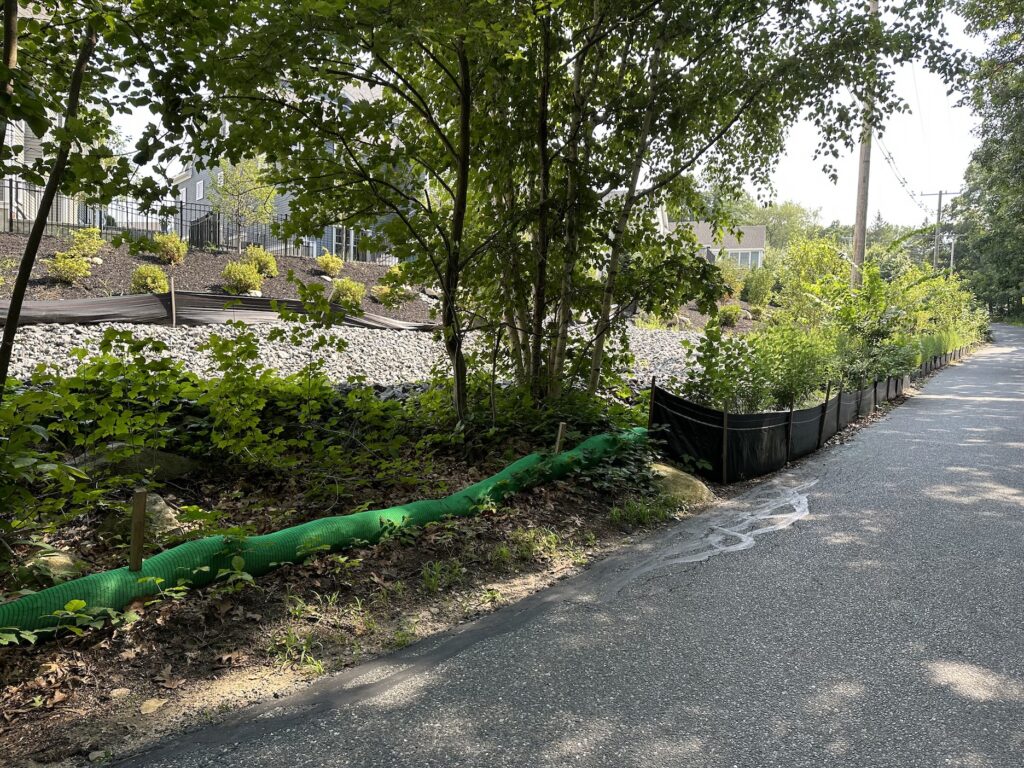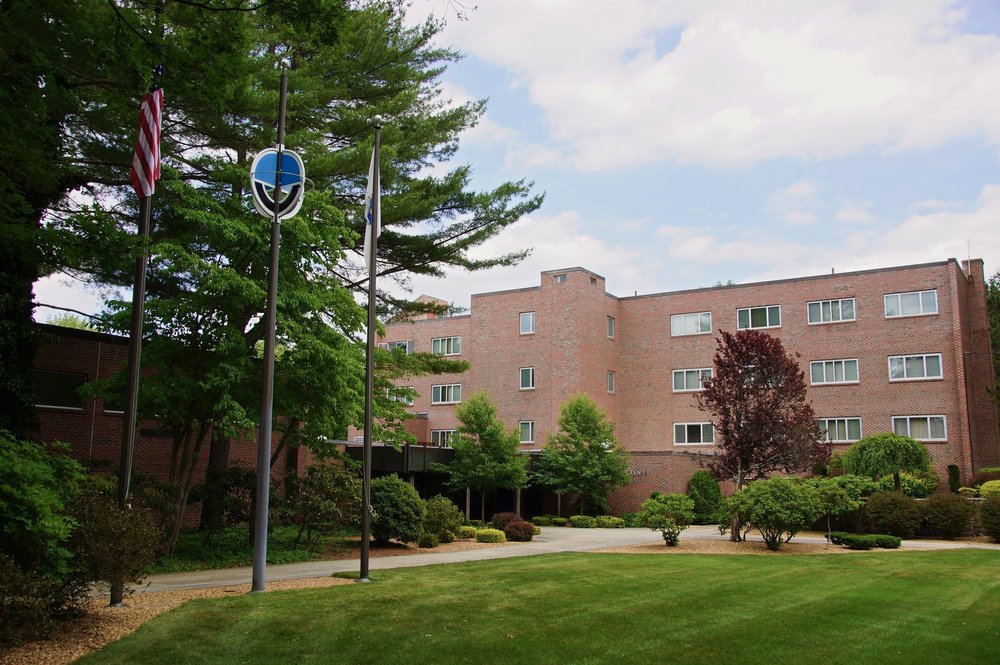The Conservation Commission met for more than three hours Tuesday night and voted 6-0 to continue a notice of intent hearing on the Massachusetts Laborers Training facility’s proposed gas line so that alternative routes proposed during the hearing could be reviewed.
The project, located at 37 East Street, has been discussed over the course of several months. The main point of contention has been the location of a proposed gas line that would involve site work on the Clinton Street right of way from Front Street. This gas line, which project attorney George Connors continually has stressed is the preferred option for the developer, would run through the main campus and necessitate the removal of about 100 trees. It would begin at Clinton Street and cross the campus, going behind the Maloney maintenance building. It would then continue around the pond to the ball field area and end at the dormitory building.
The previously presented alternative plan would have the gas pipeline go down Clinton Street to East Street into the campus. Abutters to the property voiced support for this option at a previous meeting, noting that they would like the opportunity to connect to the gas line.
In response to meeting feedback, Connors said that two other alternative pipeline options have been proposed. Both would also start on Clinton Street, but each one would run on opposite sides of Cold Spring Brook, one before it and the other beyond it. They appeared to be relatively equal in length on the plans.
Alternative 4 would run along a cart path parallel to the brook, Connors said. It is about 10-12-feet wide. It would need to be expanded to 25 feet in width to accommodate construction vehicles. This option would involve fewer trees being removed than the third option, although the updated number of trees was not provided.
Member Ted Barker-Hook questioned Connors about the second option going from Clinton to East Street. He asked for the number of trees that would be removed. Connors replied that “nine or 11 trees” would need to be cut, according to an arborist he consulted, noting that it is a scenic road.
“So if I’m only thinking of trees — and I know that’s not the only consideration — it’s 100 versus nine between those two routes,” Barker-Hook said.
Connors noted that if the gas line were to go the Clinton Street to East Street route, Eversource would be working on the road for “well over 20 or 30 days.”
“I hate to make a joke at this point,” said member Ed Harrow. “But I think people in Hopkinton would put up with 20 days of traffic delay on East Street after all they put up with on Main Street.”
He added that he believed the fourth option “would be a good compromise.”
Connors continued his argument from previous meetings that the alternatives to his preferred option would bear significant costs. With the first option, Eversource would be providing the gas line for free, and the students would be preforming about $700,000 worth of labor. The entire cost of the campus expansion project will be about $60 million, according to Connors. Once the main line is installed, about $400,000 worth of work will be needed to connect the line to the buildings.
He also said “it would make a lot more environmental sense” for the facility to use the natural gas that Eversource will be providing rather than diesel fuel.
For the Clinton-East option, the cost would be about $1.75 million and would involve directional drilling under culverts on Clinton Street, Connors added.
Chair Jeff Barnes questioned whether a natural gas pipeline anywhere on the site still would be a viable option. He noted that state legislation recently passed is requiring buildings to phase out the use of natural gas by 50 percent by 2030 and 100 percent by 2050.
Said Barnes: “It just seems to me that, with that kind of directive in Massachusetts, why are we putting in new gas lines to supply this?”
While he said he appreciated the alternative analysis, he also noted that there are utility easements in roads, “and that’s typically where you would like to see utilities go.”
Residents continued to voice their support for the Clinton-East option. Abutter David Fajardo showed a picture of the trees to be removed from the viewpoint of his yard. He described the land as “undisturbed wetlands.” He juxtaposed this with a picture of the land at Legacy Farms North where a gas line had been installed that has not yet been revegetated.
He said the handful of houses affected by the tree removal “are also the houses that would be affected by construction on Clinton Street, noting that he preferred the latter option.
“The answers to your questions have been all about money and budget and what it would cost Eversource and what it would cost the laborers,” he said. But the cost to the residents’ property values would have a bigger impact on their lives, Fajardo stressed.
Abutter Jim Araya said that he would “almost guarantee” that there are more than 100 trees that will be removed. Trees removed on East Street would be able to be regrown, while there would be “a permanent negative impact” on property values if the first option is approved.
Barnes noted that the commission votes based on environmental impacts rather than financial ones.
Member Jim Ciriello said he was “still very troubled” by the route through the campus, preferring the Clinton-East version.
The committee did vote unanimously to approve the notices of intent to allow construction of the fire suppression line as well as the work needed on Clinton Street to the currently proposed ingress to the property. Connors said he would like to table the application to dredge the pond, noting the poor water quality there.
Turkey Ridge Estates makes modifications to stormwater control measures
The other major case discussed was the Turkey Ridge Estates proposed development at 52 Cedar Street Extension, near the Southborough border.
At the previous meeting, Conservation Administrator Kim Ciaramicoli said that she had witnessed a violation of erosion controls on Dec. 29, causing her to issue a partial cease and desist order on construction.
She said there had been a “blowout in erosion controls” that caused sedimentation to be washed out into the riverfront and proceed into the Sudbury River. While she said that “a number of strides” were taken to correct the issue, “there is still stormwater flowing actively out of the site” caused by the recent snow and rainfall.
Said Ciaramicoli: “I’d love to see some additional work.”
Developer Shane Perrault said it is his “plan to make sure it doesn’t happen again.” He retained Goddard Engineering earlier in January to help develop an erosion control plan. Riprap stone has been installed around the roadways that were somewhat washed out in December, and there are now emergency spillways.
“Yes, water is flowing through the erosion controls,” he said. “But there is no sediment. We’re doing everything we can. We’ve made major progress despite the snow and rain.”
He added that the mitigation work should be completed “in the next four to six weeks.” The infrastructure for house construction will be in place by mid-March.
Barnes noted that both temporary basins are “almost at capacity.” This concerned him with anticipated rain.
Goddard representative Andrew Thibault noted that the snow had pushed back work to measure the depth of the sediment plumes, which he explained typically is “done by hand only.”
“As soon as the area is exposed enough for us to get out there and measure, we’re going to have a plan specific to that area,” he said. “So in our opinion, I think that everything is under control.”
Thibault asked the committee to reconsider the fines in light of the progress made by the applicant. The commission voted unanimously to hold the $29,100 in fines over a 12-day period in abeyance pending progress on the site.
“We’re going to stay on top of this,” Barnes said.
Hearings postponed
Hearings on the Legacy Farms North and South mitigation plan and The Trails development were postponed until the next meeting on Feb. 7.
















0 Comments